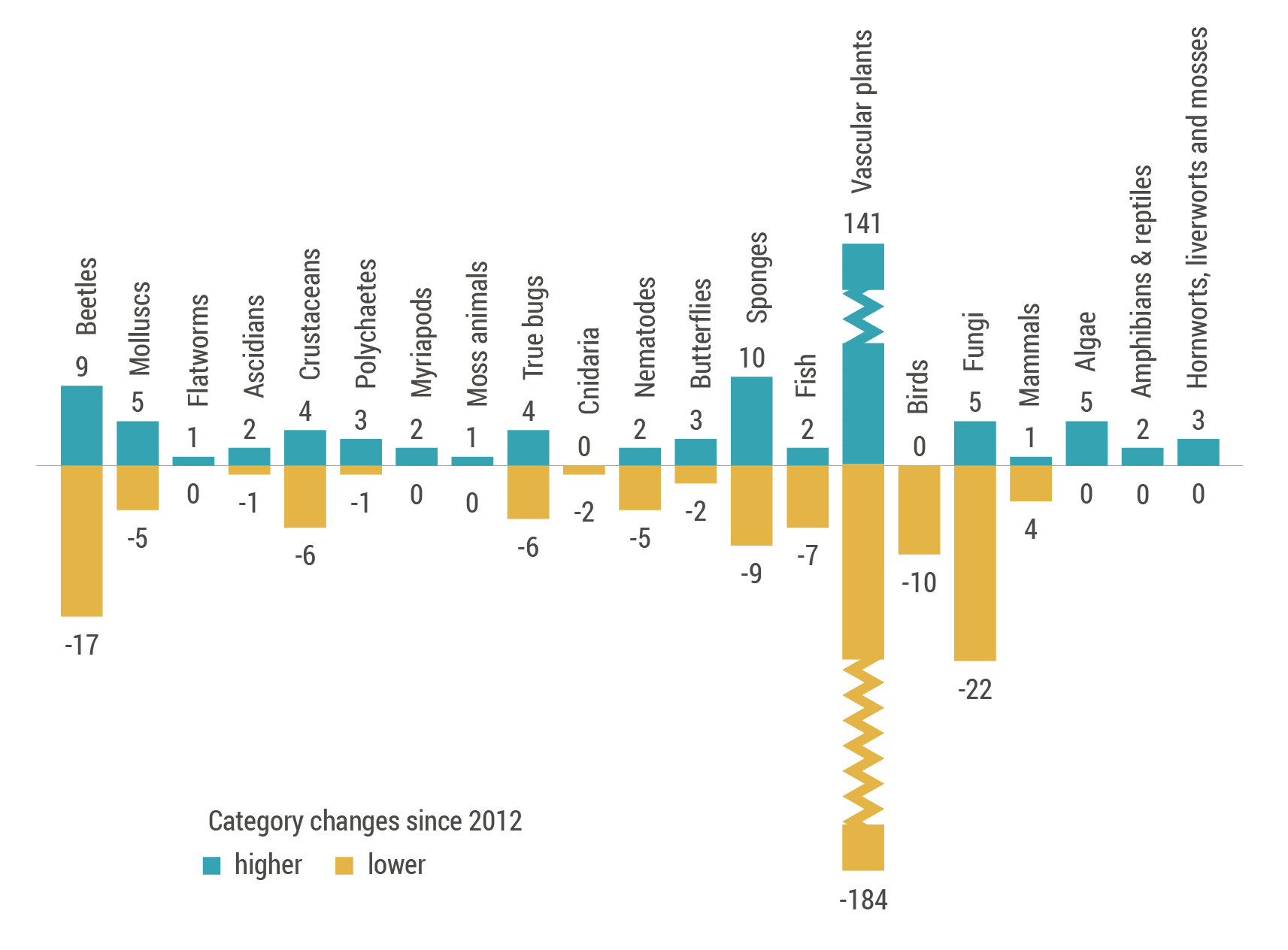Changes in category from 2012 to 2018
The Norwegian Alien Species List 2018 for mainland Norway and its maritime waters contains 1473 assessed species. Of these, 1081 were also assessed in 2012. A total of 45 percent of the re-assessed species have had their category revised and most of these species have been placed in a lower category.
- Innhold
- Several species placed in a lower category
- New species and previous assessments
- When did the species become established in Norway?
- Few species on Svalbard have changed cateogory
As a result of comprehensive survey activity, a considerable amount of new knowledge, about alien species, has been gathered since the previous alien species list was published in 2012. This contributes to more precise assessments of both dispersal speed and ecological impact. Many species have therefore had their risk category changed after the experts revised the assessments from 2012. In addition, the criteria against which species are assessed has been adjusted, something which also affects the results.
Several species placed in a lower category
In total, 486 of 1081 re-assessed species have been allocated to a new category. Of these, 281 species have been placed in a lower category, while 205 have been placed in a higher category. Most species have had their category adjusted either one level up or down eg. from high impact to severe impact or from high impact to potentially high impact. There are 98 species that have shifted two or more levels.
The set of criteria which is used has been changed from the previous edition. This, in combination with new knowledge about the species, makes it difficult to interpret what the category changes are due to. We cannot say that all these changes represent a genuine change in the ecological risk posed by the species. Nonetheless, such information is available for most of the species if the assessments are examined in detail.
In total there are 36 door knocker species which have been allocated to a higher category and 27 which have been placed in a lower category. Climate change increases the probability that door knocker species can become established and disperse in Norway, and therefore constitute a risk. It is worth noting that there can be some uncertainty regarding the ability of door knocker species to establish themselves and disperse in Norway. In such cases assessments need to be based on studies from comparable regions in other countries.
The number of species, divided into different species groups, which have gone up or down in a risk category. The result is based on the 1081 species which were evaluated in both 2012 and 2018.
New species and previous assessments
There are 392 species which were evaluated for the first time in 2018. The species groups with the greatest number of new species are vascular plants (242 species), fungi (52 species) and beetles (21 species). A key characteristic of species assessed for the first time in 2018 is that there is a greater percentage of species in the category no known impact (46%) than was the case in 2012 (29%).
In 2012 the species groups springtails Collembola and sawflies Symphyta were evaluated. These evaluations have not been revised. The assessments are still current but they are based on an older version of the methodology.
When did the species become established in Norway?
Alien species that were already established in Norway by 1800 are not to be risk-assessed. Such species are considered to be autochthonous (native) in Norway. In some cases it can be difficult to determine with certainty when the species became established in Norway, and whether they are naturally occurring. Scotch broom Cytisis scoparius and small-flowered evening primrose Oenothera ammophila are examples of species where a more detailed assessment, and verification of old sources, have led to the conclusion that these species should be assessed as alien despite their being considered native in the Red List 2015. Scotch broom Cytisis scoparius has therefore shifted category from least concern in the Red List 2015 to severe impact in the Alien Species List 2018, while small-flowered evening primrose Oenothera ammophila has gone from vulnerable in the Red List to low impact in the Alien Species List.
Few species on Svalbard have changed cateogory
Only 10 species which have been assessed separately for Svalbard have been revised, and of these there are 4 which have changed category. All are vascular plants and all have been given a lower risk category. In addition, there are 37 species evaluated for Svalbard for the first time in 2018, where the largest groups are crustaceans, with 14 species, and vascular plants with 10 species.
